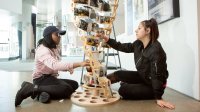3 Steps to Getting Started With PBL
If you’re hesitant about project-based learning, here’s how you and your students can begin to get the long-term benefits.
Your content has been saved!
Go to My Saved Content.When things get unpredictable, I choose to ride the wave, not fight it. Recently, I’ve leaned into the chaos by trying things I’ve been avoiding. I start small and iterate. For example, while implementing project-based learning may seem scary, it’s possible, and now even more critical for students than ever.
From YouTube to Twitch to TikTok, young people are finding ways to learn about what’s important and relevant to them. Educators should nurture students’ desires to go down rabbit holes connected to their passions and interests. When students recognize the purpose of what they’re learning, they’re more likely to dig deeper, and teachers who lead students to solve problems with authentic projects have learners who are more invested in engaging with new content.
While providing students with projects like creating a poster, running a business via a simulation, or pretending to debate may seem easier to implement, these activities can limit student voice and deeper learning.
Teachers Benefit From PBL
If doing it for your students isn’t enough, PBL is much more fun for the teacher whose role shifts from assessor to coach. It’s also aligned with teaching frameworks like Danielson and Marzano because integrating the method into your practice is a way to meet the needs of more learners.
Ultimately, implementing any scale of PBL shifts an educator’s assessment skills. You may already know that it’s best practice to use grading as a feedback loop; the loop makes more sense and is easier to apply when students are working on projects that require iteration and multiple edits.
How to Get Rolling With PBL
1. Start small: Behavior is more powerful than belief, so change your behavior first with something concrete, like transforming one unit of instruction. Shift from teaching about triangles to a unit about building bridges. You’ll still introduce essential vocabulary and formulas, but students will be more excited. Change your end-of-unit assessment from multiple choice to one that gives learners more opportunities to show what they know, like an elevator pitch followed by a Q&A.
Offer students experiences that require them to share their knowledge beyond written form. Instead of having them solve equations by hand, allow them to create a coding program or a how-to video. Quickly convert a traditional writing assignment to one where students write a script for a 3-minute video on the same topic.
Encourage regular exploration of different software, platforms, and media to solve problems and create. Instead of simply instructing students, do a jigsaw-style breakout where they become experts with one tool and then teach their peers what they know.
2. Find help: There are loads of PBL lesson plans and resources available. From PBLWorks, Teaching Channel, and Edutopia to EduTwitter, school/district/local groups, and, most important, the teachers down the hall, you have help. Don’t start from scratch—take a recipe and adjust it for your students.
Set aside time for your students to share with you. One of my favorite projects required students to pick a topic they loved and figure out how it was connected to mathematics. While this assignment took critical class time, it was an investment because I learned more about how to motivate my students than I would have by covering content alone. As the year progressed, I was better equipped to support them, thanks to my knowledge of their personal passions from that project.
3. Tell your story: Go public, share with others, or start a personal journal to document your learnings and grow your craft. Record your instruction and share with a friend or relative who is a teacher, a peer teacher, or a coach from your district or a program like EdConnective or New Teacher Center.
Shine spotlights on your lesson successes and failures. Post a reflection on a personal teacher blog or use Twitter to microblog like George Couros or Jennifer Gonzalez. We live in a world where telling your story and making it public is part of growing. Personally, I struggle here, but writing this piece has helped me to remember that I can start small.
Embrace the Change
Even though it may seem like implementing project-based learning is a lot more work, when your students have more fun, they learn more, and you just might, too.
In the year 2022, life still isn’t normal. Make the best of it by experimenting with PBL for your students. Enable them to participate in meaningful work connected to their interests so that they want to show you what they know and can do. It’s up to you to decide—will you be a creature of habit, afraid to evolve, avoiding the unknown? Or will you optimize the chaos, change what you do for the benefit of students, and embrace the new normal while integrating some PBL into your practice?
